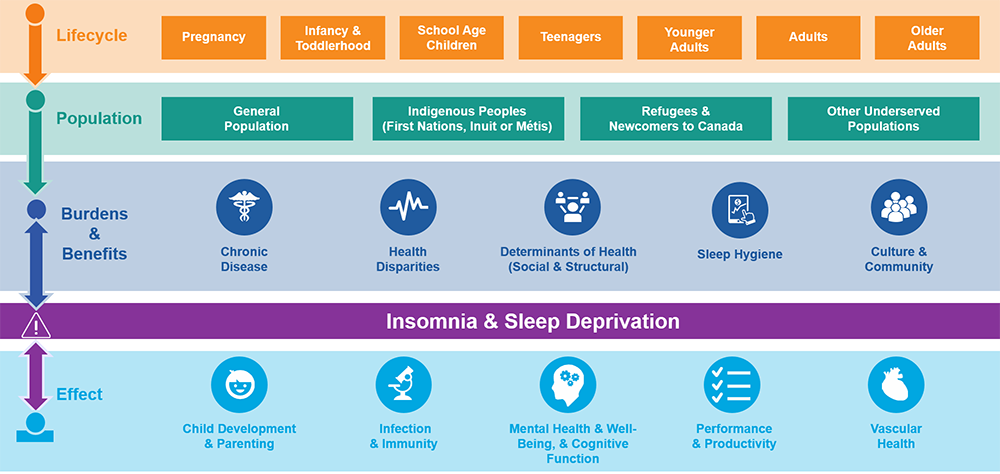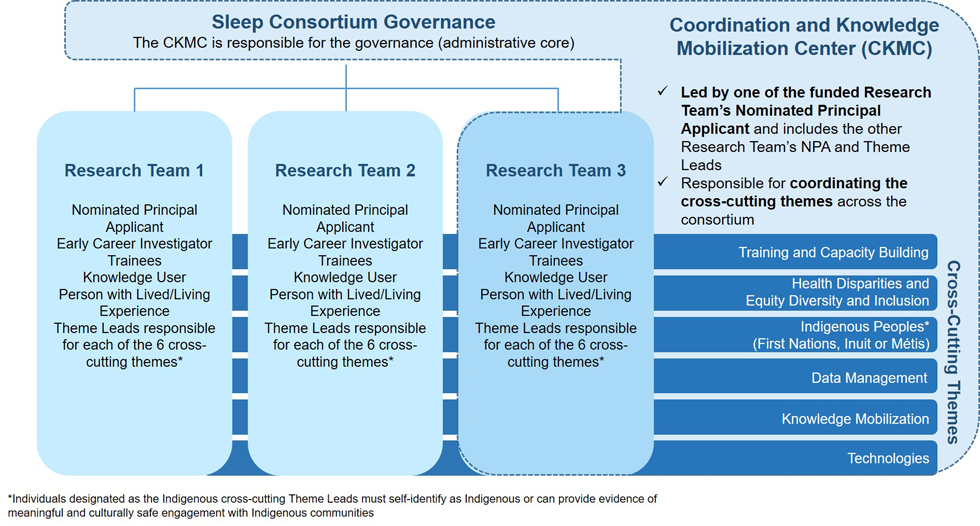Sleep Research Consortium Funding Opportunity
The following figures are related to the Sleep Research Consortium Funding Opportunity.
Figure 1: Insomnia – Cause and Effect across the Lifecycle

Figure 1 – Long description
The figure depicts the complex relationship between the causes and effects that insomnia and sleep deprivation have across the lifecycle as well as within various groups within the population, and highlights contributors that can influence this relationship both beneficially or detrimentally. Insomnia is a recognized health problem that can affect individuals across the lifecycle including pregnant women, infants and toddlers, school aged children, teenagers, and younger, middle-aged, and older adults. The incidence and prevalence of insomnia and sleep deprivation is experienced differently across populations including within the general population, Indigenous communities (First Nations, Inuit, and Métis Peoples), refugees and newcomers to Canada, and other underserved populations (e.g., racialized communities, persons living with different capabilities, and members of LGBTQ2+ communities). There are a number of beneficial (benefits) and detrimental (burdens) contributors that have a bi-directional effect on insomnia and sleep deprivation. Burdens and benefits include (but are not limited to): chronic disease (e.g., cardiovascular and cerebrovascular disease and dementia), health disparities (e.g., racism, sex and gender), social and structural determinants of health (e.g., substance use, sleep security), sleep hygiene (e.g., technologies) and connections to culture and community (e.g., ceremony and land-based healing). The effects of insomnia and sleep deprivation also exert bi-directional influence, as these effects can also lead or further contribute to insomnia and sleep deprivation. Effects include (but are not limited to): child development and parenting, infection and immunity, mental well-being and cognitive function, performance and productivity (e.g. number of vehicular collisions, industrial injuries, medical errors, performance in school), and vascular health.
Figure 2: Consortium Structure Model

Figure 2 – Long description
The Sleep Research Consortium (the Consortium) funding opportunity Consortium structure model includes three (3) individual Research Teams. One (1) of the funded teams will be awarded additional funds to function as a Coordination and Knowledge Mobilization Centre (CKMC) for the Consortium. The CKMC will be responsible for coordinating the development of a governance structure to integrate Research Team activities across a number of defined Cross-Cutting Themes within the Consortium. The Consortium governance structure will include a Consortium Administrative Core (i.e., Steering Committee), that will comprise of the CKMC NPA, each Research Team’s NPA, and Cross-Cutting Theme Leads (at the minimum). In addition, representatives that reflect the sleep community, people with lived/living experience, and other key stakeholder groups, including Indigenous communities (as appropriate), will be required to be part of the Consortium governance structure. The development of the governance structure will be led by the funded CKMC Nominated Principal Applicant (NPA) in collaboration with the other two (2) Research Team NPAs and the Theme Leads from each Research Team. Each Research Team will be interdisciplinary and to be comprised of the following (at a minimum): the NPA, Early Career Investigator(s); trainee(s); a Knowledge User; a Person with Lived/Living Experience; and Theme Leads for each of the Consortium Cross-Cutting Themes. The six (6) Consortium Cross-Cutting Themes include: Training and Capacity Development; Health Disparities and Equity, Diversity and Inclusion (EDI); Indigenous Peoples (First Nations, Inuit or Métis); Data Management (respecting FAIR and CARE principles); Knowledge Mobilization; and Technologies. For the Indigenous Peoples’ Cross-Cutting Theme, the identified CKMC Theme Lead and each Research Team Lead, must be an individual who self-identifies as Indigenous or can provide evidence of meaningful and culturally safe engagement with Indigenous Peoples.
- Date modified: